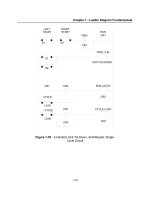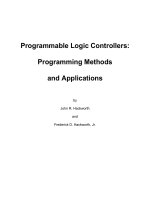Global asset allocation new methods and applications
Bạn đang xem bản rút gọn của tài liệu. Xem và tải ngay bản đầy đủ của tài liệu tại đây (3.87 MB, 337 trang )
Global Asset
Allocation
John Wiley & Sons
Founded in 1807, John Wiley & Sons is the oldest independent publishing company in the United States. With offices in North America,
Europe, Australia, and Asia, Wiley is globally committed to developing and marketing print and electronic products and services for our
customers’ professional and personal knowledge and understanding.
The Wiley Finance series contains books written specifically for finance and investment professionals as well as sophisticated individual investors and their financial advisors. Book topics range from
portfolio management to e-commerce, risk management, financial
engineering, valuation and financial instrument analysis, as well as
much more.
For a list of available titles, please visit our Web site at
www.WileyFinance.com.
Global Asset
Allocation
New Methods and Applications
HEINZ ZIMMERMANN
WOLFGANG DROBETZ
PETER OERTMANN
John Wiley & Sons, Inc.
Copyright © 2003 by Heinz Zimmermann, Wolfgang Drobetz, and Peter Oertmann. All
rights reserved.
Published by John Wiley & Sons, Inc., Hoboken, New Jersey.
Published simultaneously in Canada.
No part of this publication may be reproduced, stored in a retrieval system, or transmitted in
any form or by any means, electronic, mechanical, photocopying, recording, scanning, or
otherwise, except as permitted under Section 107 or 108 of the 1976 United States Copyright
Act, without either the prior written permission of the Publisher, or authorization through
payment of the appropriate per-copy fee to the Copyright Clearance Center, Inc., 222
Rosewood Drive, Danvers, MA 01923, 978-750-8400, fax 978-750-4470, or on the web at
www.copyright.com. Requests to the Publisher for permission should be addressed to the
Permissions Department, John Wiley & Sons, Inc., 111 River Street, Hoboken, NJ 07030,
201-748-6011, fax 201-748-6008, e-mail:
Limit of Liability/Disclaimer of Warranty: While the publisher and author have used their best
efforts in preparing this book, they make no representations or warranties with respect to the
accuracy or completeness of the contents of this book and specifically disclaim any implied
warranties of merchantability or fitness for a particular purpose. No warranty may be created
or extended by sales representatives or written sales materials. The advice and strategies
contained herein may not be suitable for your situation. You should consult with a
professional where appropriate. Neither the publisher nor author shall be liable for any loss of
profit or any other commercial damages, including but not limited to special, incidental,
consequential, or other damages.
For general information on our other products and services, or technical support, please
contact our Customer Care Department within the United States at 800-762-2974, outside the
United States at 317-572-3993 or fax 317-572-4002.
Wiley also publishes its books in a variety of electronic formats. Some content that appears in
print may not be available in electronic books.
For more information about Wiley products, visit our Web site at www.wiley.com.
Library of Congress Cataloging-in-Publication Data:
Zimmermann, Heinz.
Global asset allocation : new methods and applications / Heinz
Zimmermann, Wolfgang Drobetz, Peter Oertmann.
p. cm. — (Wiley finance series)
ISBN 0-471-26426-1 (cloth : alk. paper)
1. Asset allocation. 2. Investments, Foreign. 3. Globalization
—Economic aspects. I. Drobetz, Wolfgang. II. Oertmann,
Peter. III. Title. IV. Series.
HG4529.5.Z56 2003
332.67’3—dc21
2002009972
Printed in the United States of America.
10 9 8 7 6 5 4 3 2 1
preface
his book is about global asset allocation decisions. The benefits of
international asset allocation have been recognized for a long time.
H. Grubel, H. Levy, M. Sarnat, and B. Solnik demonstrated the benefits of international diversification more than 25 years ago, when only
a small number of global investment opportunities were available. This
picture has drastically changed. Most institutional investors, such as
pension plans or insurance companies, invest a substantial part of
their assets in foreign markets, sectors, and currencies, and mutual
funds offer a wide range of global investment products at reasonable
cost. The globalization of the economy has progressed dramatically in
this time period, which is particularly true for the internationalization
of the financial system, including the banking sector. Financial services have become a truly global business.
Many excellent books have been published on these topics over
the past years, for example, Frankel (1994), Ledermann and Klein
(1994), Giddy (1994), Jorion and Khoury (1995), Solnik (2000),
Smith and Walter (2000), to mention just a few. The distinguishing
feature of this book is its attempt to incorporate recent methodological advances in the treatment of the various topics. Much progress has
been made in the statistical modeling of time-varying risk and return
characteristics of financial markets. These tools make it possible to
shed new light on the time-varying relationship between volatility and
the correlation between markets and sectors, and to investigate the
implications for international asset allocation strategies. This literature also suggests a “dynamic” view of the risk-return trade-off of financial assets: Risk premia are time-varying and predictable based on
changing business conditions. Numerous econometric research has
tested the time-series and cross-sectional implications of conditional
multifactor asset pricing models. This research has major implications for the implementation of dynamic (tactical) asset allocation
T
v
vi
PREFACE
strategies, as well as the measurement of investment performance. Finally, a substantial part of the recent progress in the asset pricing literature relies on test strategies based on stochastic deflators. This
approach is extremely useful to investigate the degree to which markets are integrated or segmented in terms of the pricing of systematic
risk across national borders, sectors, or entire asset classes. This has
important implications for asset allocation strategies, but also for
corporate funding decisions.
This book focuses on the practical applications of these methodological advances for global asset pricing and portfolio decisions.
Original empirical work is presented throughout the book.
Most of the chapters were originally presented at two Global
Asset Allocation Conferences organized by Peter Oertmann and
Heinz Zimmermann in October 1999 and October 2000, respectively, in Zurich, Switzerland. We are grateful to the Swiss Institute of
Banking and Finance (s/bf) at the University of St. Gallen for hosting
the conferences. The senior author of this book was then a director
of the Institute. The presented papers were evaluated by the organizers of the first conference, and a few were refereed by outside reviewers. Earlier versions of Chapters 4 and 10 were published in the
Journal of Financial Markets and Portfolio Management, where a
German version of Chapter 6 was published also. All chapters have
been updated and revised from the papers originally presented.
While the three authors of this book bear full responsibility for
the content of this volume, we gratefully acknowledge the contribution of David Rey, the author of Chapter 4, who did an excellent job
in preparing the final version of the entire manuscript; and of Viola
Markert, co-author of Chapter 8. We also acknowledge the motivating comments and suggestions by the participants of the conferences,
as well as by our students and colleagues. We hope that this volume
will stimulate further research in this area.
HEINZ ZIMMERMANN
WOLFGANG DROBETZ
PETER OERTMANN
Basel and St. Gallen, Switzerland
October 2002
contents
CHAPTER 1
The Global Economy and Investment Management
1
Executive Summary
Motivation
Globalization and Risk
Globalization and Expected Returns
Globalization and the Market Price of Risk
Tactical Asset Allocation and Estimation Risk
About This Book
1
2
2
3
4
4
5
CHAPTER 2
International Asset Pricing, Portfolio Selection, and
Currency Hedging: An Overview
7
Executive Summary
Introduction
Valuation in an International Setting: Basic Facts
Purchasing Power Relationships
The Core Problem of International Asset Pricing
Portfolio Selection and Asset Pricing I
Utility-Based Asset Pricing Models—Overview
The Basic International Capital Asset Pricing
Model (IntCAPM) without Deviations from PPP
Portfolio Separation and the IntCAPM in Real Terms
The IntCAPM in Nominal Terms
Portfolio Selection and Asset Pricing II
Accounting for PPP Deviations and “Real”
Exchange Rate Risk
The Solnik-Sercu International Asset Pricing Model
From Partial to General Equilibrium
General Models Accounting for Domestic Inflation
Currency Hedging
Equilibrium Currency Hedging
Universal Currency Hedging
7
8
9
10
12
13
13
14
15
16
18
18
19
27
30
36
37
38
vii
viii
CONTENTS
Free Lunch and Full Currency Hedging
Overlay Currency Hedges
International Arbitrage Pricing Theory
Pricing Condition with Currency Risk Adjustment
The Solnik Pricing Condition
Summing Up the Main Streams
CHAPTER 3
The Anatomy of Volatility and Stock Market Correlations
Executive Summary
Introduction
Data and Descriptive Statistics
An Asymmetrical Model of Volatility
The Correlation Structure of International Stock Returns
Correlation and Volatility
Upmarket and Downmarket Correlations
Business Cycles and Correlations
Investment Implications
Diversification in Upmarkets and Downmarkets
Shortfall Risk
Value-at-Risk
Option Pricing
Conclusion
CHAPTER 4
The Correlation Breakdown in International Stock Markets
Executive Summary
Motivation
Analysis of the Stock Return Series
Description of the Data
Summary Statistics
International Equity Market Correlations
Time-Measured Observations
Moving Estimation Windows
Realized Correlation Constructed from Daily Data
Is There a Time Trend?
Event-Measured Observations
Correlation Breakdown
What Actually Is an (Extreme) Event on Financial Markets?
39
40
41
42
45
47
51
51
51
53
58
64
64
70
74
76
77
79
80
84
86
89
89
90
91
92
92
93
95
96
98
101
105
105
106
Contents
Empirical Evidence: Based on Realized Correlations
Empirical Evidence: Based on Monthly Return Data
Implications for Asset Management
Optimal Portfolios from Event-Varying
Variance-Covariance Matrices
Conclusion
CHAPTER 5
Global Economic Risk Profiles: Analyzing Value and Volatility
Drivers in Global Markets
Executive Summary
Introduction
Empirical Methodology
The Return-Generating Process
The Pricing Restriction
Data Description
Stock and Bond Market Returns
Specification of Global Risk Factors
GERP—A First Inspection of the Markets’ Risk Profiles
Factor Profiles for Stock Markets
Factor Profiles for Bond Markets
Explanatory Power of the Factor Models
Discriminating between Volatility and Value Drivers
Testing the Pricing Potential of the Risk Factors:
Wald Tests
Potential Value Drivers for Stock Markets
Potential Value Drivers for Bond Markets
Choosing the Common Factors
Assessing the Power of Value Drivers: Testing the
Pricing Equation
Conclusion
Appendix
CHAPTER 6
Testing Market Integration: The Case of Switzerland and Germany
Executive Summary
Introduction
Integration and Correlation
ix
107
110
115
116
119
121
121
121
123
124
125
126
126
127
129
131
133
133
134
134
135
137
137
138
141
142
145
145
146
150
x
CONTENTS
Two Models for Testing Integration
A Consumption-Based Test for Market Integration
A Beta Pricing Model with an Unobservable
Benchmark Portfolio
Data
Description of the Data for the Consumption-Based
Integration Test
Description of the Data for the Latent Variable Model
Empirical Results of the Tests for Integration
Results of the Consumption-Based Test for Integration
Results of the Latent Variable Test for Integration
Conclusion
Appendix
CHAPTER 7
Emerging Market Investments: Myth or Reality?
Exeuctive Summary
Motivation
Data
Emerging Markets and Diversification
The Mean-Variance Analysis Revisited
The Stein-Estimator
Simulating Portfolio Strategies with and without Shrinkage
Simultaneous Investment in MSCI and IFC Markets
Investment in MSCI Markets
Investment in IFC Markets
Conclusion
CHAPTER 8
The Structure of Sector and Market Returns: Implications
for International Diversification
Executive Summary
Introduction
The Setup of the Problem: Two Numerical Examples
Structure of the Indices
Characteristics of the Datastream Index Family
Statistical Properties of the Index Returns
The Temporal Behavior of Index Volatilities
and Correlations
152
152
157
161
161
163
164
164
166
168
169
173
173
174
176
183
187
190
192
194
196
196
197
199
199
200
202
208
208
209
214
Contents
Markets, Sectors, and Extreme Market Events
Efficient Frontiers
Simple Diversification Strategies
Two-Dimensional Diversification Strategies
Analyzing Specific Portfolios
Conclusion
xi
216
219
219
222
223
227
CHAPTER 9
The Value-Growth Enigma: Time-Varying Risk Premiums and
Active Portfolio Strategies
229
Executive Summary
Introduction
Exploration of a Phenomenon
Open Questions for Value Investors
Insights from the Empirical Analysis
Data Description
Empirical Facts on International Value-Growth Spreads
Long-Horizon Value Premiums
Short-Horizon Value Premiums
International Correlations of Value Premiums
Economics of International Value-Growth Spreads
Instrumental Regression Framework
Global Forces Driving Value Premiums
Global Integration of Value Premiums
Tactical Style Rotation Strategies
Devising a Simple Switching Strategy
Performance of Active Value-Growth Strategies
Conclusion
229
230
230
231
232
233
234
234
237
239
244
244
248
250
253
253
253
259
CHAPTER 10
Integrating Tactical and Equilibrium Portfolio Management:
Putting the Black-Litterman Model to Work
Executive Summary
Introduction
The Deficiencies of Standard Portfolio Theory
Amount of Required Input Data
Extreme Portfolio Weights
Sensitivity of Portfolio Weights
Mismatch in Levels of Information
261
261
262
263
263
264
266
267
xii
CONTENTS
Neutral Views as the Starting Point
The Black-Litterman Approach
Long-Term Equilibrium
Expressing Views
Combining Certain Views
Combining Uncertain Views
A Simple Example
Incorporating a Relative View
Incorporating an Absolute View
Conclusion
Appendix
267
271
272
273
275
276
277
277
280
283
284
BIBLIOGRAPHY
287
NOTES
301
INDEX
309
Global Asset
Allocation
Zimmermann Unpaged Galleys Frontmatter
xv
CHAPTER
1
The Global Economy and
Investment Management
EXECUTIVE SUMMARY
Globalization, or more precisely, integration of financial markets
implies the convergence of risk premiums between national markets, sectors, and other market segments. In integrated financial
markets, risk is priced consistently across national markets and
currencies.
The most important reason for increased integration is the liberalization and deregulation of capital markets, with relaxed investment restrictions, free cross-border capital flows, and significantly
lower transaction costs.
Globalization affects expected risk premiums through three
main channels: the profitability of firms, the structure of the market portfolio, and the pricing of global risk.
Whether markets are integrated or (at least partially) segmented
has important implications for the design of asset allocation
strategies as well as the cost of capital of firms.
This chapter gives a brief overview of the material covered in this
book.
1
2
GLOBAL ASSET ALLOCATION
MOTIVATION
Financial markets have become increasingly globalized over the past
two decades for a number of reasons, including:
The globalization of the economies themselves.
The broader recognition of the benefits of international diversification.
The decreasing role of purchasing power and foreign exchange
risk in Western economies.
The progress and internationalization of information technology
and communication systems.
The emergence of global trading systems.
The decrease of information and transactions costs for international trades.
The institutionalization of investors such as pension funds, mutual funds, and hedge funds, with a broad focus on international
investments.
The trend toward international investments is a natural consequence of the overall globalization of the economies and the international financial system. However, the question remains: How exactly
are portfolio diversification strategies affected by the general trend
toward globalization?
GLOBALIZATION AND RISK
Neglecting transaction costs and capital market imperfections, global
portfolio decisions are determined by the risks and expected returns
on national markets as well as global sectors. A first observation,
well documented in numerous empirical studies, is that country-bycountry correlations between global stock and bond market returns
have substantially increased over the past decades. Alan Greenspan
and Wall Street seem to be the leading indicators for what happens on
The Global Economy and Investment Management
3
the exchanges across the rest of the world (see Oertmann, 1997, for an
interesting empirical study on this subject). This increase in correlations has dramatic effects on the risk of globally diversified portfolios.
Global systematic risk has increased substantially. This implies that
the international diversification benefits reported in the early studies
by Grubel (1968), Levy and Sarnat (1970), and Solnik (1974c) have
largely disappeared in recent years. From a practical standpoint, what
are the investment implications: staying at home, taking a different
asset allocation approach (e.g., a sector approach), or investing in
nontraditional asset classes such as hedge funds, private equity, commodities, or emerging markets?
GLOBALIZATION AND EXPECTED RETURNS
We cannot derive investment implications without taking expected returns into account. Asset allocation decisions always reflect a tradeoff
between risk and expected returns. Globalization affects expected returns through three main channels: the profitability of firms, the structure of the market portfolio, and the pricing of global risk. The first
effect is immediately obvious: Globalization is a major force for the
competitive power of firms, sectors, and countries; it determines their
profitability, growth potential and, finally, expected returns. Second,
globalization has a substantial effect on the industrial structure of national economies (or international sectors), and consequently also affects the composition of the major stock market indices. Even ignoring
the growth of alternative investments and mutual funds, the investment universe has changed substantially over the past decade (e.g.,
due to numerous initial public offerings, or IPOs, and the associated
growth of the information technology and communication sectors).
This has had a substantial effect on the composition of the relevant
market (or benchmark) portfolio, which in turn affects equilibrium
expected returns on individual assets. Third, globalization affects the
pricing of market risk (i.e., the unit price of nondiversifiable risk in the
economy). The next section discusses this third channel in depth.
4
GLOBAL ASSET ALLOCATION
GLOBALIZATION AND THE MARKET PRICE OF RISK
In the development of the financial sector, new products (e.g.,
funds), markets, and financial instruments (e.g., derivatives) that
have been introduced to transfer economic and financial risks could
potentially affect the size of the risk premiums demanded by investors. In addition, the emergence of institutional investors—acting
under different constraints than private investors—has probably
changed the aggregate risk tolerance of the market and, therefore,
the magnitude and the temporal behavior of market risk premiums.
But most important, the liberalization and deregulation of capital
markets with relaxed investment restrictions, free cross-border capital
flows, and significantly lower transaction costs has led to an increased
integration of markets. In integrated markets, risk is priced consistently across national markets and currencies. Whether markets are
integrated or (at least partially) segmented has important implications
for asset allocation strategies. In integrated markets, there should be
less room for tactical asset allocation strategies than in segmented
markets—investors diversify their portfolios to reach their desired
level of expected return. If markets are (partially) segmented, investors
use active return bets to improve portfolio performance by overweighting markets where they perceive attractive risk-return tradeoffs.
However, to determine whether markets are integrated or segmented requires a joint test of integration and market equilibrium. Integration is conceptually related to the consistency of expected
returns across markets or sectors, but expected returns must be derived from an underlying asset pricing model. The results of empirical
tests for integration are notoriously hard to interpret because one
cannot distinguish which of the two underlying hypotheses fails.
TACTICAL ASSET ALLOCATION AND
ESTIMATION RISK
Portfolio optimization tools and simulation techniques are widely
used to investigate the impact of alternative market assumptions and
The Global Economy and Investment Management
5
parameter specifications on the optimal asset allocation. If investors
would fully agree on estimated returns, volatilities, and correlations
of the relevant asset classes, they would passively hold the market
portfolio. But most investors have individual views and opinions
about markets and sectors, and thus over- and underweight selected
asset categories relative to the market. In the aggregate, however,
these categories must add up to the market portfolio. Thus, as investors, we must ask: How can we incorporate the level and confidence of our individual estimates and forecasts to portfolio strategies
consistent with capital market equilibrium?
ABOUT THIS BOOK
Chapter 2 contains an overview of international asset allocation and
asset pricing models, including a discussion on currency hedging. It
grew out of a series of lecture notes used by Peter Oertmann and
Heinz Zimmermann in their international finance classes. Chapters
3 and 4 cover the observation that stock market volatility and correlation are substantially different in up and down markets. The two
chapters contain detailed analyses of this empirical observation and
discuss the implications for diversification strategies and risk management.
Chapter 5 describes an empirical methodology that is useful in implementing global asset allocation strategies. It empirically explores
common economic determinants of returns (volatility drivers) as well
as expected returns (value drivers) across international stock and
bond markets. The empirical results lead to the conclusion that multiple sources of global economic risk affect both the variability of returns and the valuation on international stock and bond markets. To
control the variance and measure the performance of an internationally diversified portfolio including both stock and bond positions, a
framework with multiple global risk factors is preferable to the singlefactor model specified in the international Capital Asset Pricing
Model (CAPM).
6
GLOBAL ASSET ALLOCATION
Chapter 6 presents an econometric test on the integration of
stock markets. As mentioned, whether markets are integrated is
important not only for tactical asset allocation strategies but also
for corporations in optimizing their financial structure. The same
methodology can be used to test whether new investment opportunities expand the risk-return menu from existing investments in
an economically meaningful sense. Chapter 7 investigates whether
emerging stock markets can be seen as integrated parts of the developed worldwide stock markets.
Chapter 8 addresses whether global sector diversification strategies produce risk-return patterns different from asset allocation rules
defined in terms of national markets. This question is important
not only for portfolio managers, but also for financial analysts. In
Chapter 9, strategies exploiting a specific investment style-value and
growth characteristics of stocks are analyzed in a global asset pricing
framework by implementing active style rotation strategies.
Finally, Chapter 10 shows how the approach originally developed
in the Black-Litterman (1992) model can improve global asset allocation decisions. The approach combines a passive (market equilibrium) approach with an investor’s subjective view of markets, based
on his or her confidence in the forecasts. This is a useful methodology because it allows investors to take an intermediate view about
the informational efficiency of markets.
CHAPTER
2
International Asset
Pricing, Portfolio Selection,
and Currency Hedging
An Overview
EXECUTIVE SUMMARY
International asset pricing models differ from domestic asset
pricing models because currency risk and institutional barriers to
international diversification such as investment restrictions or
transaction costs, capital controls, and political risk (to mention
just the most important) must be considered.
This chapter focuses on currency risk or, more specifically, on
purchasing power risk and its role in efficient diversification
strategies, hedging decisions, and asset pricing.
If purchasing power parity (PPP) holds, there is no currency risk,
no currency hedging, and no currency risk premium—the simple
Capital Asset Pricing Model (CAPM) can be extended to an international setting.
If exchange rates are correlated with stock market returns, exchange rate risk is not fully diversifiable, and investors hedge
against exchange rate risk.
Different models have been developed to demonstrate the diversification, valuation, and hedging effects of exchange rate risk. In
this chapter, the classical models of Solnik (1974a), Sercu (1980),
Stulz (1981a), Adler and Dumas (1983), and Black (1989) are
presented in an integrative survey.
7
8
GLOBAL ASSET ALLOCATION
The currency hedging decision is part of the overall diversification strategy and it cannot be separated from the asset allocation
across markets. Currencies are best regarded as separate asset
classes.
This casts serious doubts on the adequacy of “overlay” currency
hedging strategies often implemented in practice.
In general, currency risk is associated with a positive risk premium, implying that currency hedging is not a free lunch and full
hedging is not optimal.
A partial equilibrium model of international asset pricing can be
constructed postulating a CAPM-like relationship conditional on
a minimum-variance currency hedge implemented by investors.
However, a general equilibrium model (including equilibrium on
currency forward markets) is much more difficult and relies on
unobservable variables.
Universal—noninvestor-specific—currency hedge funds as postulated by Black (1989, 1990) only exist under special circumstances.
INTRODUCTION
International asset pricing models are similar in structure to the valuation concepts developed in the closed-economy setting. The mainstream theories of beta pricing, the single-beta Capital Asset Pricing
Model (CAPM), the Arbitrage Pricing Theory (APT), and the multibeta IntCAPM can be extended to international pricing relationships
in principle. However, such extensions require assumptions on the behavior of exchange rates, on consumption, and on the investment opportunity sets in different countries. Some of these assumptions are
quite restrictive. Country-specific consumption and investment opportunities imply that investors from different countries perceive asset returns differently. A central factor in international valuation theory is
the examination of how these differences affect the investors’ portfolio
holdings and expected returns in a certain numéraire currency. Two
strands of theory development can be identified. First, some models









